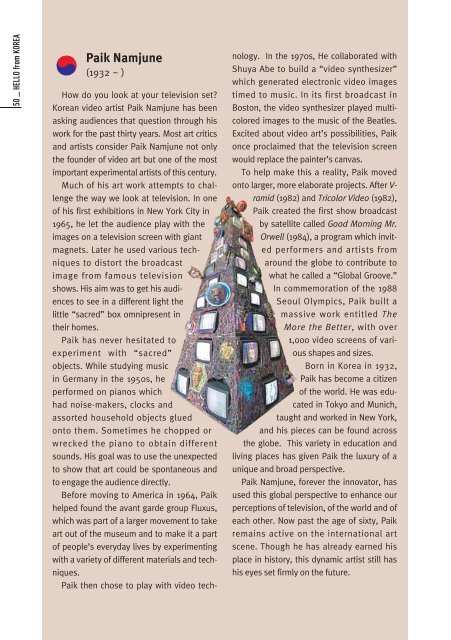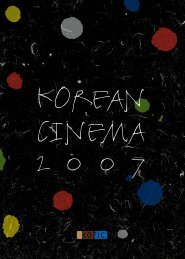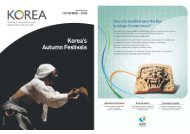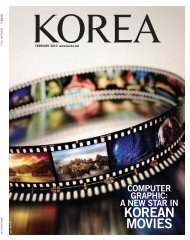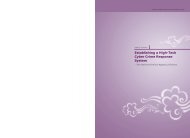HELLO from KOREA
Hello-Eng(3.3) - Korea.net
Hello-Eng(3.3) - Korea.net
- No tags were found...
You also want an ePaper? Increase the reach of your titles
YUMPU automatically turns print PDFs into web optimized ePapers that Google loves.
50 _ <strong>HELLO</strong> <strong>from</strong> <strong>KOREA</strong><br />
Paik Namjune<br />
(1932 ~ )<br />
How do you look at your television set?<br />
Korean video artist Paik Namjune has been<br />
asking audiences that question through his<br />
work for the past thirty years. Most art critics<br />
and artists consider Paik Namjune not only<br />
the founder of video art but one of the most<br />
important experimental artists of this century.<br />
Much of his art work attempts to challenge<br />
the way we look at television. In one<br />
of his first exhibitions in New York City in<br />
1965, he let the audience play with the<br />
images on a television screen with giant<br />
magnets. Later he used various techniques<br />
to distort the broadcast<br />
image <strong>from</strong> famous television<br />
shows. His aim was to get his audiences<br />
to see in a different light the<br />
little “sacred” box omnipresent in<br />
their homes.<br />
Paik has never hesitated to<br />
experiment with “sacred”<br />
objects. While studying music<br />
in Germany in the 1950s, he<br />
performed on pianos which<br />
had noise-makers, clocks and<br />
assorted household objects glued<br />
onto them. Sometimes he chopped or<br />
wrecked the piano to obtain different<br />
sounds. His goal was to use the unexpected<br />
to show that art could be spontaneous and<br />
to engage the audience directly.<br />
Before moving to America in 1964, Paik<br />
helped found the avant garde group Fluxus,<br />
which was part of a larger movement to take<br />
art out of the museum and to make it a part<br />
of people’s everyday lives by experimenting<br />
with a variety of different materials and techniques.<br />
Paik then chose to play with video technology.<br />
In the 1970s, He collaborated with<br />
Shuya Abe to build a “video synthesizer”<br />
which generated electronic video images<br />
timed to music. In its first broadcast in<br />
Boston, the video synthesizer played multicolored<br />
images to the music of the Beatles.<br />
Excited about video art’s possibilities, Paik<br />
once proclaimed that the television screen<br />
would replace the painter’s canvas.<br />
To help make this a reality, Paik moved<br />
onto larger, more elaborate projects. After V-<br />
ramid (1982) and Tricolor Video (1982),<br />
Paik created the first show broadcast<br />
by satellite called Good Morning Mr.<br />
Orwell (1984), a program which invited<br />
performers and artists <strong>from</strong><br />
around the globe to contribute to<br />
what he called a “Global Groove.”<br />
In commemoration of the 1988<br />
Seoul Olympics, Paik built a<br />
massive work entitled The<br />
More the Better, with over<br />
1,000 video screens of various<br />
shapes and sizes.<br />
Born in Korea in 1932,<br />
Paik has become a citizen<br />
of the world. He was educated<br />
in Tokyo and Munich,<br />
taught and worked in New York,<br />
and his pieces can be found across<br />
the globe. This variety in education and<br />
living places has given Paik the luxury of a<br />
unique and broad perspective.<br />
Paik Namjune, forever the innovator, has<br />
used this global perspective to enhance our<br />
perceptions of television, of the world and of<br />
each other. Now past the age of sixty, Paik<br />
remains active on the international art<br />
scene. Though he has already earned his<br />
place in history, this dynamic artist still has<br />
his eyes set firmly on the future.


